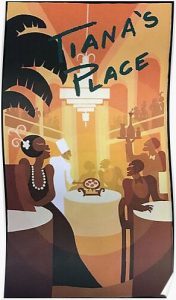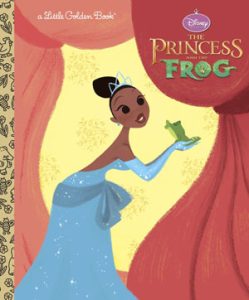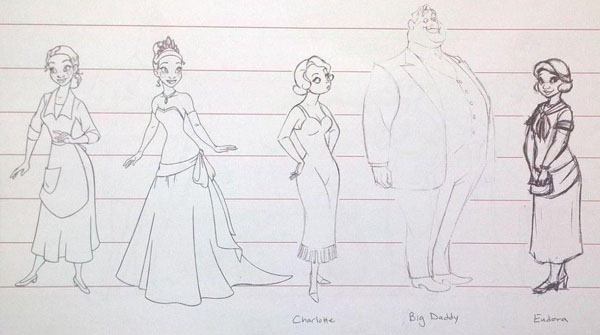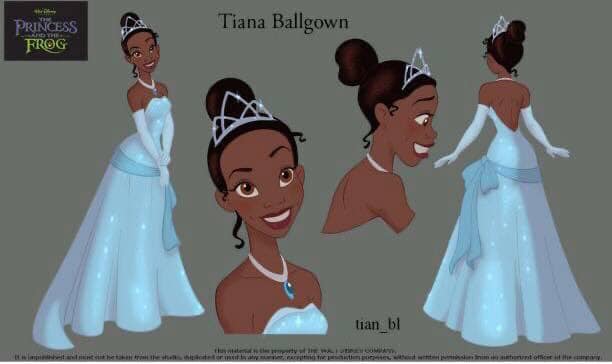The Walt Disney Company announced that Disney+ will be getting an animated series titled Tiana based on the heroine in the animated feature film The Princess and the Frog (2009). Of course, this is just part of business synergy with the Disney theme park ride Splash Mountain now being re-themed to the film.
When the movie was first released, I was not particularly impressed when I saw it in the theater. I didn’t think it was a bad film, just not memorable. However, over the years and repeated viewings, I have come to appreciate its charm much more.
In fact, I think many of the Disney animated films made within the last two decades that were considered unsuccessful on their initial release may be due for a re-evaluation of their worth.
The animated feature was very loosely based on the 2002 novel The Frog Princess by E.D. Baker where the princess kisses the frog and turns into one herself. It began production under that working title in 2006.
Disney immediately changed several key elements to the film after receiving numerous complaints of racial insensitivity. Besides re-titling the picture to avoid the implication that the first African-American Disney princess was somehow ugly or an animal, the lead character’s name changed from “Maddy” (a nickname for “Madeline”) to “Tiana”, since “Maddy” sounded too much like “Mammy.”
 A subplot about the heroine working as a chambermaid, her love interest being non-ethnic and other things were also dropped to avoid negative stereotypes. In addition Oprah Winfrey was hired as a technical consultant and later given a voice role as Tiana’s mother.
A subplot about the heroine working as a chambermaid, her love interest being non-ethnic and other things were also dropped to avoid negative stereotypes. In addition Oprah Winfrey was hired as a technical consultant and later given a voice role as Tiana’s mother.
The film avoids any questions about segregation and racial injustice during that Jim Crow era and implies that Tiana’s difficulties in opening her own restaurant is the result of her being poor (only having the down payment for the sugar mill while another buyer can pay the full price) and being a single woman in a white male dominated society.
Some things that are racially related are implied including the fact that the band performers and Tiana are not masked at the masquerade, reflecting local New Orleans law at that time that prohibited blacks from covering their faces. Dr. Facilier has broken the law by hiding behind a white Janus-faced mask so he is clearly a villain.
Disney attempted to establish a “color blindness” since it is just a romanticized fairy tale and not a historical documentary. Charlotte has no hesitation wanting to marry Prince Naveen even though an interracial marriage would have been illegal at the time. Even the close friendship between Charlotte and Tiana would have been out-of-the ordinary during that era.
While with the release of Home on the Range (2004), the Walt Disney Company had announced it would cease producing 2D hand-drawn animation, ironically the arrival of John Lasseter and Ed Catmull from Pixar to take over the animation department resulted in them insisting that this new film be produced in 2D hand-drawn animation to maintain the Disney heritage of such animation.
 Pixar had been working on a film with the working title The Spirit of New Orleans: A Pixar Ghost Story because of Lasseter’s fondness for the city and some of that work was incorporated into the final film. He brought back Ron Clements and John Musker who were part of the Disney animation renaissance but had left the studio when hand drawn animation was eliminated to co-direct the film. The directors spent ten days in Louisiana before starting to write the film.
Pixar had been working on a film with the working title The Spirit of New Orleans: A Pixar Ghost Story because of Lasseter’s fondness for the city and some of that work was incorporated into the final film. He brought back Ron Clements and John Musker who were part of the Disney animation renaissance but had left the studio when hand drawn animation was eliminated to co-direct the film. The directors spent ten days in Louisiana before starting to write the film.
It was decided to make the film an “American fairy tale” set in the 20th Century with the inspiration for the New Orleans scenes to be Lady and the Tramp (1955) and the scenes in the bayou to be The Rescuers (1977).
“Because hand-drawn animation was gone, it was almost like building the studio again,” Clements said. “Some of the 2D artists had become 3D stars, but many had just left altogether. Yet, just about everybody who did draw wanted to come back. We put together an all-star team of animators.”
In addition to current and former Disney animators, the production crew, which topped 300 at its peak, included recent graduates from the California Institute of the Arts. “They had studied hand-drawn animation without knowing if they’d have a place to apply their learning, and they blossomed into real talent,” Musker said.
Clements added, “With this type of animation, you have to work with a mentor to learn how to do it and get proficient. It’s a craft and an art that requires a lot of dedication. But, there’s an intuitive connection about drawing, from the brain to the hand to paper, that people miss with computer animation. With just the flip of a pencil, you can change an expression. That casual interaction is much tougher with 3D.”
For the first time, the directors used something that was common at Pixar: layout animatics. They filmed the storyboards and added the dialog track to see the film but also added staging and lighting.

“We took the storyboards to the next step,” Musker says. “We added camera moves and compositing. We wanted to know if the composition was strong enough to carry the idea quickly, so we composed all our shots in black and white to see the values. Being able to evaluate that in real time, with real lights and darks, was a valuable step.”
The animatics were created using Harmony and Photoshop. In-house tools then linked individual scenes created in those programs to entire sequences. Effects artists also worked directly with Harmony; however, layout, character animation including all the in-betweens, and cleanup all originated on paper.
“We wanted this film to look handcrafted,” said Marion West, visual effects supervisor. “But there are some fireflies and some vehicle wheels that are 3D, and some 3D doors open and shut in Maya. But, it’s a very, very understated use of 3D.”
“The background paintings were ninety-nine percent handcrafted. They were done in Photoshop, but they were drawn or inked or painted one stroke at a time. The painters applied every brush stroke as they would with a regular painting.”

The film went on to gross $104.4 million in the United States and Canada, and $271 million worldwide, making it a box office success but it was perceived as a failure because it did not “ignite the box office” like The Little Mermaid or Aladdin.
It out-grossed the fairly recent films including The Emperor’s New Groove, Atlantis: The Lost Empire, Treasure Planet, Brother Bear and Home on the Range.
The title of the film made the potential audience think it was just a “little girl’s film” and Disney marketing did nothing to alleviate that misconception. Audiences that did go to see it gave it favorable ratings although surveys showed that people thought it was “old-fashioned”. The film was also overshadowed by the release of James Cameron’s Avatar a week after it debuted.
Unfortunately, what the Walt Disney Company thought they learned from the experience was that hand drawn animation was not popular with current audiences and so future films should all be computer animated.



 Jim Korkis is an internationally respected animation historian who in recent years has devoted his attention to the many worlds of Disney. He was a columnist for a variety of animation magazines. With his former writing partner, John Cawley, he authored several animation related books including The Encyclopedia of Cartoon Superstars, How to Create Animation, Cartoon Confidential and Get Animated’s Animation Art Buyer’s Guide. He taught animation classes at the Disney Institute in Florida as well as instructing classes on acting and animation history for Disney Feature Animation: Florida.
Jim Korkis is an internationally respected animation historian who in recent years has devoted his attention to the many worlds of Disney. He was a columnist for a variety of animation magazines. With his former writing partner, John Cawley, he authored several animation related books including The Encyclopedia of Cartoon Superstars, How to Create Animation, Cartoon Confidential and Get Animated’s Animation Art Buyer’s Guide. He taught animation classes at the Disney Institute in Florida as well as instructing classes on acting and animation history for Disney Feature Animation: Florida.




















































This film was actively marketed as introducing the first African-American Disney Princess. This would have been well and good if this had been what the film was actually about. However, instead of featuring scenes of this new Disney Princess character, the film presents her for most of its running time as a green frog. She only regains her natural form at the very, very end of the film. This seems to me to be a somewhat insensitive way to introduce a potential new Disney star. While there are precedents in Disney features of a human turning into an animal–such as “The Emperor’s New Groove,” “Brother Bear,” and even “Beauty and the Beast”–there is an implication in those earlier films that becoming an animal is a form of retribution or punishment for one’s social sins. Thus, in “The Princess and the Frog” it seems somewhat demeaning to reduce the heroine Tiana to the form of a frog–and it also goes against the marketing of the time which was emphasizing Tiana as a role model for young women of all races. If the target audience for the film consisted of frogs, this transformation would make perfect sense–but what human is going to look to a frog to serve as a role model? This is my biggest problem with the film Tiana herself is beautifully animated and a wonderful, strong personality without being overbearing. She could have carried the entire film in her human form. I went to the film expecting to see this new Disney Princess in action–and instead I got a frog.
I kept thinking of the song “Bein’ Green” and the message of the song when she is a frog. Surely, you could’ve at least seen the abstract connetion of that. Matter of fact, I still want to see Rose do a duet of Bein Green with Kermit either during a special or event (like D23). Something similar to when Lena Horne sang it to Kermit on “Sesame Street” in 1973.
“The Princess and the Frog” is a beautiful movie with an engaging story, vivid characters, some good laughs, and a few really touching moments. I also love New Orleans and southern Louisiana as much as John Lasseter does, and the film not only captures the atmosphere of the setting, but makes it magical. I’m not a fan of Randy Newman, but the singers and arrangers make the most of his material, and the musical numbers are well staged. Disney productions of the early 2000s tended to contain heavy-handed moral messages, in this case the notion that nothing worthwhile can be achieved without hard work; however, none of Tiana’s hard work would have mattered in the end without a boost from voodoo magic and a best friend with a rich father. I’m sure Big Daddy Le Boeuf owed his success, social standing and St. Charles Avenue mansion to a great deal of hard work — other people’s hard work, that is. Please excuse the cynicism.
The movie is also sad. It was a last-ditch effort by Musker and Clements to persuade Disney that traditional animation could still produce solid entertainment for audiences AND make a profit for the company. They proved it, and yet it didn’t work. So much for the idea that hard work pays off in the long run.
I recall driving past the Burbank Disney animation studio shortly after HOME ON THE RANGE was released, and seeing a giant pile of dozens of vintage ‘Kem Weber’ animation desks in the parking lot.
Some of those desks might’ve been headed for ‘storage’ .. but I’m sure many were sold off, discarded or destroyed. The phrase “burning the bridge behind us” certainly came to mind. -_-
The cartoon kind of grew on me. I thought it was okay the first time I saw it but got more fonder of it each time I viewed it. The Tiana character is quite engaging and you really do find yourself rooting for her at the climax of the film. My only criticism would be with the music. I was hoping for a bit more in the way of a 1920s New Orleans jazz feel (Jelly Roll Morton, Sam Morgan, Sharkey Bonano, Wingy Manone tunes for example). But oh well!
Actually, it wasn’t the last traditional Disney animation feature to date. Walt Disney Feature animation got one more doing a second Winnie the Pooh feature simply called “Winnie the Pooh” in 2011. Unfortuantly, the short length feature film (over an hour long similar to “Dumbo”) was stupidly released the same time as the final Harry Potter film and got completely over shadowed at the box-office.
Which brings me to the recnet “Tiana” mini-seres which will be released on Disney+ next year (where the herorine will assuming to be human the entire time). When more details were announced during the Disney+ event, it was revealed that rather than being done my their Television Animation studio like other TV spin-offs, it is going to be produced by Walt Disney Feature Animation themeselves. Shortly after that, news came about that Disney was planning to hire and train new traditional animators for new projects. While they didn’t say what projects are, I would suspect this upcoming mini-series will be one of the new productions that the new generation is gearing up for (although, they may have some extra help from another smaller tradition animation studio). Hopefully, this might be a start of a path for Disney to get back on doing traditinal animation feature films again and I feel like audiences are ready for something “new” in animation.
It’s good. It should have been great. At least it’s memorable; featuring the first Disney princess who earned her title (okay, and of color), and the onscreen death of a “good” character. But one gets the impression that the studio wasn’t quite as wholeheartedly behind the project as it was for the CGI features (which are now kind of blurring into each other).
“But one gets the impression that the studio wasn’t quite as wholeheartedly behind the project as it was for the CGI features (which are now kind of blurring into each other).”
I hate to hear someone say a similar thing to stop-motion animation.
In 2019, the Motion Picture Academy held a 10th Anniversary screening plus a Q&A with some of the cast and crew. The theatre was packed with black women whom I judged to be largely between 16 and 22, and their reaction made it obvious that this had been a very special film to them in their childhood–and still was. As an old white guy, I certainly couldn’t relate to it on their level, but strictly as entertainment I feel it’s one of Disney’s finest and am glad it’s finally being rediscovered.
There was so much passion and dedication that went into the making of The Princess and the Frog and upon rewatching it, the end result shows. With that said, it honestly sounds to me like the Walt Disney Company learned the wrong lessons from the critics’ and audiences’ responses.
But it did not out-gross Disney’s 2008 CGI-animated feature, Bolt. I suspect that might have had something to say too.
I saw it in the theaters when it was released (A 2d animated movie? Golly!) and left the theater completely unimpressed. Something about it bothered me and I couldn’t put my finger on it….
Then a month or so ago I decided to give it another go. I found the dvd for a bargain and watched it again. The film is gorgeous! I could watch it with the sound off and marvel at it. Tiana is a great character. Dr Facilier? Too cartoonishly expressive. He was more cartoonish than menacing…. kinda smarmy, a little.
About halfway through it, when they made it to the blind woman in the swamp and after the musical number I realized what it was: the songs are bad. There’s no soul to the songs. Maybe more New Orleans jazz influences were needed? There’s little rhythm or movement to them. Almost like someone said “Here’s some scenes we think the focus groups will say test well. Write some songs with these titles. Oh, here’s the names of the characters, fit them into the songs and the songs can’t last more than 1 1/2 minutes if that long. You’ve got 3 weeks. I’m off to Aspen.”